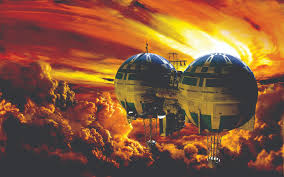
It would be a one-way trip. The ship would sink deeper into clouds of ammonia of water vapor until the intense atmospheric pressure and heat compressed the hydrogen around it into molten liquid. Science-fiction writers have proposed exploring the gas giants in hot-air balloons high above the crushing depths below.
Gas giants may have a rocky or metallic core—in fact, such a core is thought to be required for a gas giant to form—but the majority of its mass is in the form of the gases hydrogen and helium, with traces of water, methane, ammonia, and other hydrogen compounds.
Unlike rocky planets, which have a clearly defined difference between atmosphere and surface, gas giants do not have a well-defined surface; their atmospheres simply become gradually denser toward the core, perhaps with liquid or liquid-like states in between.
Picture Credit : Google




